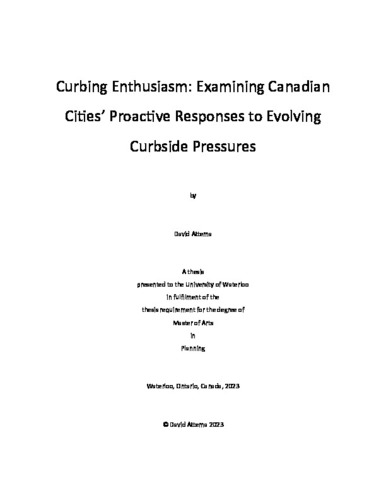| dc.description.abstract | Transportation planning is increasingly concerned with the role the curb plays in urban environments. As the primary boundary separating mobility, accessibility, and amenity activities along a street, it is a highly contested interface between all three. In recent years the number and diversity of curb uses has exploded, placing even greater pressure on this facility. Traditional activities such as on-street parking are being squeezed by new mobility services, e-commerce deliveries, infrastructure supporting shifting transportation modes, and outdoor dining and amenity spaces, to name a few. New innovations such as autonomous transportation will likely further disrupt this mix of uses. As municipal policymakers struggle to keep pace with rapid changes at the curb, some are turning to a new, proactive approach: curbside management. By streamlining curb governance, establishing curb user priorities, incorporating flexibility of uses, and monitoring curb performance using new technologies, curbside management promises to improve outcomes for a greater number of street users.
Research of curbside management often focuses on specific policy aspects or technologies, but very few studies to date have helped municipalities assess their current practices or understand where a holistic approach could enhance their existing curb-related governance activities. These are important aspects to understand because many competing private curb interests do not necessarily align with the public interest for this equally public resource.
This thesis examines academic literature and practitioner guides related to curbside management to develop a best practice-based evaluation framework. This framework enables cities to examine their curb-related dimensions of governance, policy, organizational structure, and performance monitoring. Its primary intent is to help cities better understand how they presently manage their curb and determine where their greatest potential for improvements lie. The framework is applied to five case study cities in Canada—a context examined very little in curbside management research to date. Findings from these case studies reveal that organizational and policy integration, cost-effective curb utilization data collection, and streamlined by-law environments are areas with the greatest potential to improve management of the curb in Canada’s urban areas. | en |

